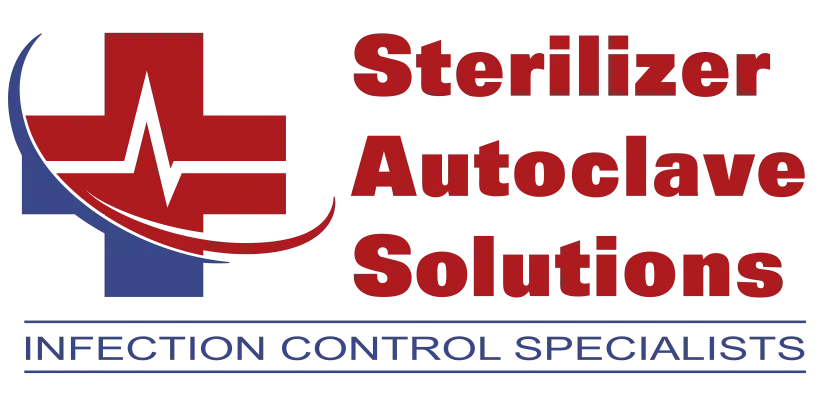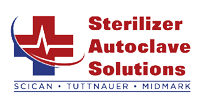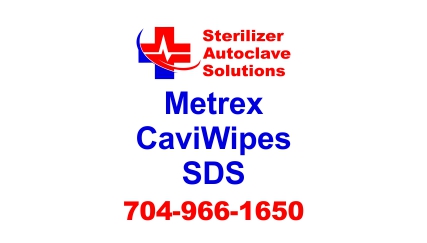Metrex Caviwipes SDS Leave a comment
In this article, we’ll show you the MSDS for the Metrex Caviwipes. If you have any questions or just want to talk to someone, call our Free Tech Support at 704-966-1650 Option 3.
METREX CAVIWIPES MATERIAL SAFETY DATA SHEET
SECTION 1. IDENTIFICATION
Product Name: CaviWipes
Recommended Use: Hard surface cleaner and disinfectant
Manufacturer: METREX® RESEARCH 28210 Wick Road
Romulus, Michigan 48174 U.S.A.
Australian Supplier: Kerr Australia Pty Limited Unit 6, 12 Mars Road
Lane Cove West, NSW 2066Australia
Telephone no.: 1 800 643 603
Email general queries: kavokerr.orders@kavokerr.com
Email technical queries: safety@kavokerr.com
Poisons Information Helpline: 131126 (24 hours)
Chemical Emergency Phone Number (Chemical Spills, Leaks, Fire, Exposure or Accident only):
CHEMTREC 1-800-424-9300 (in the US) 1-703-527-3887 (Outside the US)
SDS Date of Preparation/Revision: March/8/21
SECTION 2. HAZARDS IDENTIFICATION
GHS / HAZCOM 2012 Classification:
Flammable Liquid Category 4
Eye Irritation Category 2B
Warning!
Hazard Statement(s):
Combustible Liquid
Causes eye irritation
Prevention:
Keep away from flames and hot surfaces. No smoking.
Wash hands thoroughly after handling.
Wear eye protection.
Response:
IF IN EYES: Rinse cautiously with water for several minutes. Remove contact lenses if present and easy to do. Continue rinsing. If eye irritation persists get medical attention.
In case of fire: Use water spray or fog alcohol-resistant foam, carbon dioxide or dry chemical to extinguish.
Storage:
Store in a well-ventilated place. Keep cool.
Disposal:
Disposal of contents and container in accordance with local and national regulations.
Other Hazards: None
SECTION 3. COMPOSITION/INFORMATION ON INGREDIENTS
Component CAS No. Amount
Water 7732-18-5 70-80%
Isopropanol 67-63-0 17.2%
Ethylene Glycol Monobutyl Ether (2-Butoxyethanol) 111-76-2 1-5%
Diisobutylphenoxyethoxyethyldimethylbenzyl ammonium chloride 121-54-0 0.28%
SECTION 4. FIRST-AID MEASURES
Inhalation: Move to fresh air if effects occur and seek medical attention if effects persist.
Skin Contact: Take off contaminated clothing. Rinse skin immediately with plenty of water for 15-20 minutes. Call poison control center or doctor for treatment advice.
Eye Contact: Hold eye open and rinse slowly and gently with water for 15-20 minutes. Remove contact lenses, if present, after the first 5 minutes, then continue rinsing. Call a poison control center or doctor for treatment advice.
Ingestion: If swallowed, get medical advice by calling a Poison Control Center or hospital emergency room. If advice is not available, take victim and product container to the nearest emergency treatment center or hospital. Do not attempt to give anything by mouth to an unconscious person.
Most Important Symptoms and Effects, both Acute and Delayed: Causes mild to moderate eye irritation. Prolonged skin contact may cause irritation. Inhalation of concentrated vapors may cause dizziness and drowsiness. Ingestion may cause gastrointestinal irritation, nausea, vomiting and diarrhea.
Indication of any Immediate Medical Attention and Special treatment Needed: Immediate medical attention is not required.
SECTION 5. FIRE-FIGHTING MEASURES
Suitable (and Unsuitable) Extinguishable Media: Use water spray or fog, alcohol-resistant foam. carbon dioxide or dry chemical. Cool fire exposed containers with water.
Specific Hazards Arising from the Chemical: Combustible liquid. May form explosive mixtures in air at temperatures at or above the flashpoint. Flammable vapors may collect in confined areas. Vapors are heavier than air and may travel along surfaces to remote ignition sources and flashback. Fire exposed containers may rupture explosively.
Special Protective Equipment and Precautions for Fire-fighters: Firefighters should wear positive pressure self-contained breathing apparatus and full protective clothing for fires in areas where chemicals are used or stored.
SECTION 6. ACCIDENTAL RELEASE MEASURES
Personal precautions, Protective Equipment, and Emergency Procedures: Avoid contact with eyes. Avoid prolonged contact with skin and clothing. Wear appropriate protective clothing as described in Section 8. Ventilate the area.
Environmental precautions: Avoid release to the environment. Report spill as required by local and federal regulations.
Methods and Materials for Containment and Cleaning Up:
Eliminate all ignition sources. Ventilate area. Use explosion-proof equipment if large amounts are released. Stop leak if it is safe to do so and move containers from the spill area. Collect material with an inert absorbent material and place in appropriate, labeled container for disposal.
SECTION 7. HANDLING AND STORAGE
Precautions for Safe Handling: Avoid contact with eyes, skin and clothing. Wear appropriate eye protection when handling. Wash thoroughly with soap and water after handling and before eating, drinking, chewing gum, using tobacco or using the toilet. Remove and wash contaminated clothing before reuse. Combustible liquid. Keep away from heat, open flames and all other sources of ignition. Do not smoke in storage or use areas. Keep containers closed when not in use. Do not reuse empty containers.
Empty containers retain product residues and may be hazardous. Do not flame cut, drill, weld, etc. on or near empty containers, even empty.
Conditions for Safe Storage, Including Any Incompatibilities: Store in a cool, well ventilated area away from heat, oxidizers and all sources of ignition. Do not contaminate water, food or feed by storage.
SECTION 8. EXPOSURE CONTROLS/PERSONAL PROTECTION
Exposure Controls
Chemical Exposure Limit
Water None Established
Isopropanol 200 ppm TWA, 400 ppm STEL ACGIH TLV 400 ppm TWA OSHA PEL
Ethylene Glycol Monobutyl Ether (2- Butoxyethanol) 20 ppm TWA ACGIH TLV
50 ppm TWA OSHA PEL (skin)
Diisobutylphenoxyethoxyethyldimethyl benzylammonium chloride None Established
Appropriate Engineering Controls: General ventilation should be adequate for normal use. For operations where the exposure limits may be exceeded, mechanical ventilation such as local exhaust may be needed to minimize exposure.
Respiratory Protection: None under normal use conditions with adequate ventilation. For operations where the occupational exposure limits are exceeded, an approved respirator with an organic vapor cartridge or supplied air respirator is recommended. Equipment selection depends on contaminant type and concentration. Select in accordance with applicable regulations and good industrial hygiene practice. For firefighting, use self-contained breathing apparatus.
Hand Protection: Impervious gloves such as butyl rubber or nitrile are recommended for operations which may result in prolonged or repeated skin contact.
Eye Protection: Splash proof goggles or safety glasses are recommended if splashing is possible.
Skin Protection: Wear protective clothing if needed to avoid prolonged/ repeated skin contact. Contaminated clothing should be removed and laundered before re-use.
Hygiene Measures: Suitable eye wash and washing facilities should be available in the work area.
Other: None required over normal conditions of use.
SECTION 9. PHYSICAL AND CHEMICAL PROPERTIES
Appearance: Clear liquid
Odor: Alcohol
Odor Threshold: 0.001 ppm (ethylene glycol monobutyl ether)
pH: 11.0 – 12.49
Melting Point/Freezing Point: Not determined
Boiling Point/Range: Not determined
Flash Point: 64°C (147°F)
Evaporation Rate: Not available
Flammability (solid, gas): Not applicable
Upper/Lower Flammability or Explosive Limit: LEL: 2% UEL: 12.7%
Vapour Pressure: 43.3 mmHg @ 20°C (isopropanol)
Relative Density: 0.972
Solubility: Completely soluble in water
Partition Coefficient (n-Octanol/Water): Not determined
Auto-ignition Temperature: Not determined
Decomposition Temperature: Not determined
Viscosity: Not determined
SECTION 10. STABILITY AND REACTIVITY
Reactivity: Not reactive at ambient temperatures.
Chemical Stability: Stable.
Possibility of Hazardous Reactions: Not reactive.
Conditions to avoid: Heat, flames and all other sources of ignition .
Incompatible Materials: Strong oxidizing agents, acids and strong reducing agents.
Hazardous Decomposition Products: Thermal decomposition will produce carbon monoxide, carbon dioxide, nitrogen oxides, amines, chlorine and hydrogen chloride.
SECTION 11. TOXICOLOGICAL INFORMATION
Potential Health Effects:
Inhalation: May cause irritation of the nose, throat and upper respiratory tract. High vapor concentrations may produce nausea, vomiting, headache, dizziness, drowsiness, weakness, fatigue, narcosis and possible unconsciousness. Not acutely toxic in rats.
Skin Contact: Prolonged or repeated exposure may cause mild irritation. No signs of toxicity or irritation were observed in a dermal toxicity study in rabbits. Non-irritating in a primary irritation study with rabbits. Negative in a skin sensitization study with guinea pigs.
Eye Contact: May cause eye irritation. Moderate irritant in an eye irritation study with rabbits. Effects reversed in 7 days.
Ingestion: Ingestion may cause gastrointestinal disturbances and central nervous system effects such as headache, dizziness, drowsiness and nausea. Not acutely toxic in rats.
Chronic Hazards: None known.
Medical Conditions Aggravated by Exposure: None currently known.
Carcinogen: None of the components is listed as a carcinogen or potential carcinogen by IARC, NTP, ACGIH, or OSHA.
Acute Toxicity Levels for CaviWipes: LD50 Oral Rat >5000 mg/kg, LD50 Dermal Rat >2000 mg/kg, LC50 inhalation LC50 rat >2.08 mg/L
SECTION 12. ECOLOGICAL INFORMATION (non-mandatory)
This product is classified as Acute Aquatic Toxicity Category 3 based on the GHS criteria for aquatic toxicity. Harmful to aquatic life.
Toxicity: No toxicity data available for product.
Isopropanol: LC50 fathead minnows 11,130 mg/L/48 hr; LC50 brown shrimp 1400 mg/L/48 hr Diisobutylphenoxyethoxyethyldimethylbenzylammonium chloride: LC50 pimephales promelas 1.6 mg/L/96 hr, LC50 lepomis macrochirus 1.4 mg/L/96 hr.
Persistence and Degradability: Isopropanol and 2-butoxyethanol are readily biodegradable in screening tests. Diisobutylphenoxyethoxyethyldimethylbenzylammonium chloride is not readily biodegradable.
Bioaccumulative Potential: Isopropanol has an estimated BCF of 3 suggesting that the potential for bioaccumulation is low.
Mobility in Soil: Isopropanol is expected to have very high mobility in soil.
Other Adverse Effects: None known.
SECTION 13. DISPOSAL CONSIDERATIONS (non-mandatory)
Solution Disposal: Discharge residual and unused solutions in accordance with Federal, State, and local regulations. For used solution, the waste solution must be characterized by the generator and disposed of in accordance with Federal, State, and local regulations.
Container Disposal: Nonrefillable container. Do not reuse or refill this container. Offer for recycling, if available. If recycling is not available, discard in accordance with hospital policy.
SECTION 14. TRANSPORT INFORMATION (non-mandatory)
UN NUMBER UN Proper Shipping Name Hazard Class(s) Packing Group Environmental Hazards
US DOT None Not Regulated per alcohol exception (49CFR 173.150(e)) None None None
EU
ADR/RIDNone Not Regulated None None None
IMDG None Not Regulated None None None
IATA/ICAO None Not Regulated None None None
Transport in Bulk According to Annex II of MARPOL 73/78 and the IBC Code
Not applicable – product is transported only in packaged form.
Special Precautions – None identified
SECTION 15. REGULATORY INFORMATION
U.S. Federal Regulations:
EPA SARA 311/312 Hazard Classification: Refer to Section 2 for OSHA Hazard Classification
EPA SARA 313: This Product Contains the Following Chemicals Subject to Annual Release Reporting Requirements Under SARA Title III, Section 313 (40 CFR 372):
Ethylene Glycol Monobutyl Ether 111-76-2 1-5%
(Glycol Ether)
Protection of Stratospheric Ozone: This product is not known to contain or to have been manufactured with ozone depleting substances as defined in 40 CFR Part 82, Appendix A to Subpart A.
CERCLA SECTION 103: This product is not subject to CERCLA reporting requirements; however, many states have more stringent release reporting requirements. Report spills required under federal, state and local regulations.
US EPA Registered Pesticide: This chemical is a pesticide product registered by the United States Environmental Protection Agency and is subject to certain labeling requirements under federal pesticide law. These requirements differ from the classification criteria and hazard information required for safety data sheets (SDS), and for workplace labels of non-pesticide chemicals. The hazard information required on the pesticide label is reproduced below. The pesticide label also includes other important information, including directions for use.
CAUTION!
Harmful if absorbed through the skin. Causes moderate eye irritation. Keep out of reach of children.
International Inventories:
US EPA TSCA Inventory: All of the components of this product are listed on the Toxic Substances Control Act (TSCA) Chemical Substances Inventory or exempt.
Canadian Environmental Protection Act: All of the components in this product are listed on the Domestic Substances List (DSL) or exempt.
Australia: All of the components in this product are listed on the Australian Inventory of Chemical Substances (AICS) or exempt.
China: All of the components in this product are listed on the Inventory of Existing Chemical Substances in China (IECSC) or exempt.
European Union: All the components in this product are listed on the EINECS inventory or exempt. Japan: All of the components in this product are listed on the Japanese Existing and New Chemical Substances (ENCS) inventory or exempt.
Korea: All of the components in this product are listed on the Korean Existing Chemicals List (KECL) or exempt.
Philippines: All of the components of this product are listed on the Philippines Inventory of Chemicals and Chemical Substances (PICCS) or exempt.
Section 16: Other Information
Effective Date: March 8, 2021
Supersedes Date: September 17, 2018
Revision Summary: Sections 1, 2, 5, 7, 8, 9, 10, 11, 14 updated
The information and recommendations set forth herein are taken from sources believed to be accurate as of the date of preparation, however, METREX® RESEARCH makes no warranty with respect to the accuracy or suitability of the recommendations, and assumes no liability to any use thereof.
As always if you have any questions about this process or anything else please feel free to contact us and take advantage of our “FREE TECH SUPPORT.”
We also offer FREE VIRTUAL TECH SUPPORT to “See and Talk” with a “Real Time Live Technician” for any problems you may be in need of help with.
You can also use our “FREE MAINTENANCE PROGRAM”. Take the guesswork and worrying about what unit is due for maintenance and which maintenance cycle it is time for. We will keep track of all your autoclaves and let you know when it’s time for anything.


